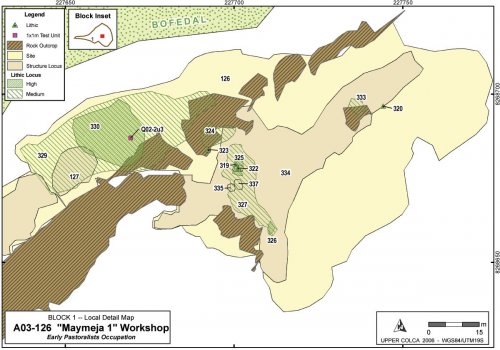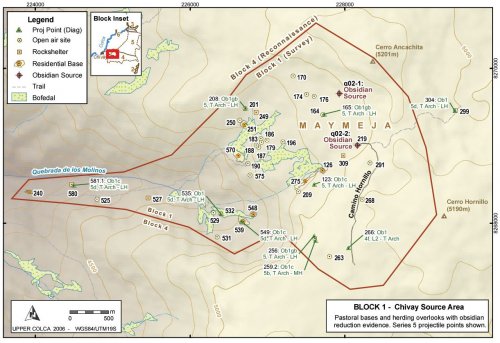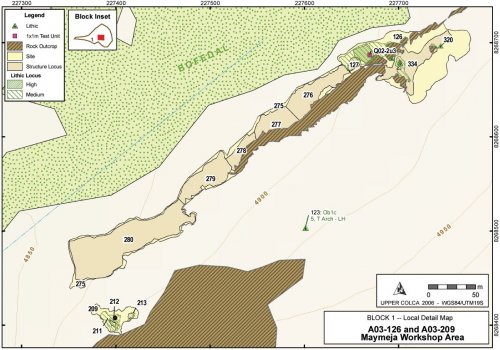Block 1 Early Agropastoralist Settlement pattern
A primary goal of modern pastoralists residing in Maymeja is to guard their flock both during daytime grazing and during the night when rustlers, foxes, and, formerly, mountain lions, are liable to attack the herd (T. Valdivia 2003, pers. comm.). It is evident from regional distributions in the Chivay Source area that during the Terminal Archaic and Formative Period there was a combined interest in herd maintenance with obsidian production. A key feature of the Maymeja area is that procuring obsidian from this zone did not require compromising grazing potential for access to obsidian: both appear to have been available on the southern margins of Maymeja.
Figure 6-49. Block 1 possible Early Agropastoral settlement pattern with Series 5 projectile points.
Residential bases: Several large sites were identified that have been interpreted as residential bases for herders. These residential bases include corrals, possible remnants of residential structures, and site maintenance activity such as the discard of lithics in discrete areas. These bases represent probable overnight camps.
Open air sites: Small sites, consisting typically of a windbreak and a small obsidian scatter overlooking a bofedal, are distributed throughout the Maymeja zone. These small camps, described here as "open air sites" are probable day-use overlooks for herders.
Rock shelters: A number of small rock shelter sites were also encountered in this area. These are typically very small rock shelters, often no more than a small overhang of a boulder or the edge of a lava flow. The shelters commonly contain a small scatter of obsidian flakes, and sometimes cores, at the dripline of the rock shelter.
Miscellaneous other site types: Other kinds of sites include an obsidian quarry pit [q02-2], and Camino Hornillo [a03-268] which is a route leading to the quarry pit from the south.
A03-126 "Maymeja 1"
On the southern edge of Maymeja a site was located that contained a dense mound of flaked obsidian, an extensive scatter of obsidian, traces of terracing and wall building, but virtually no ceramics. Dates from a 1x1m test unit [Q02-2u3] placed in the obsidian mound (Section 7.4.2) showed that this site was occupied from at least the Terminal Archaic until the end of the Early Formative.

Figure 6-50. A03-126 "Maymeja 1" workshop and vicinity.
Maymeja 1 [A03-126] belongs to a complex of features that have been divided into an upper site A03-126, and a lower site A03-275 that has some LIP and LH component. This complex is located on the dry southern margins of the Maymeja area where viscous lavas emanating from the Cerro Hornillo vent slope downwards to the northwest into the depression referred to as Maymeja. Subsequent glaciation polished these lavas into smooth banks with excavated depressions that offer adequate shelter in this exposed region. The shelter and abundant sun in this north-facing zone is compensated for by the mountain winds that blow with regularity in the area.
Figure 6-51. View of A03-126 "Maymeja" from north. Terraced area A03-334 on upper level. Test Unit Q02-02 is just right of the orange bucket. Project tents are visible in corral A03-127.
|
(a) |
Figure 6-52. (a) Workshop area of "Maymeja 1" showing proximity of bofedal, (b) Testing Q02-2U3, with the quarry pit [Q02-2] visible among light ash 600m uphill in the background.
The residential base of A03-126 consists of two principal zones that show human modification: (1) the upper area above the polished lava bluffs visible in Figure 6-51, and (2) a lower zone that abuts the bofedal to the north. As the area is almost devoid of ceramics the primary indicators of occupation are lithic scatters of varying density and with highly eroded walls and terraces. The central greatest concentration of flaked stone is the workshop area labeled as a high density lithic locus [A03-330], shown on Figure 6-50.
|
Arch_ID |
Site_ID |
Feature Type |
Description1 |
Description2 |
Area_m2 |
|
126 |
126 |
Site |
"Mayemeja 1" |
Workshop and upper sector |
6,007.0 |
|
127 |
126 |
Structure Locus |
Walls |
Corral area |
130.6 |
|
275 |
275 |
Site |
"Mayemeja 5" |
Lower slopes parallel to bofedal |
10,401.4 |
|
276 |
275 |
Structure Locus |
Wall bases only |
Eroded terraces along lower slope |
1,414.2 |
|
277 |
275 |
Structure Locus |
Wall bases only |
Eroded terraces along lower slope |
978.2 |
|
278 |
275 |
Structure Locus |
Wall bases only |
Eroded terraces along lower slope |
524.6 |
|
279 |
275 |
Structure Locus |
Wall bases only |
Eroded terraces along lower slope |
1,234.2 |
|
280 |
275 |
Structure Locus |
Wall bases only |
Eroded terraces along lower slope |
4,306.6 |
|
324 |
126 |
Lithic Locus |
Medium Density |
Concentration in on top of lava outcrop |
49.6 |
|
325 |
126 |
Lithic Locus |
High Density |
Flakes washing down from structures |
12.4 |
|
326 |
126 |
Lithic Locus |
High Density |
Concentration in sheltered area |
4.5 |
|
327 |
126 |
Lithic Locus |
Medium Density |
Expanse of flaked stone |
182.4 |
|
328 |
126 |
Lithic Locus |
Low Density |
Light scatter coterminous with site bndy |
2,942.7 |
|
329 |
126 |
Lithic Locus |
Medium Density |
Expanse of flaked stone |
940.5 |
|
330 |
126 |
Lithic Locus |
High Density |
Workshop mound |
292.1 |
|
333 |
126 |
Lithic Locus |
Medium Density |
Concentration in sheltered area |
15.6 |
|
334 |
126 |
Structure Locus |
Wall bases only |
Eroded terraces along lower slope |
1,504.4 |
|
335 |
126 |
Structure Locus |
Wall bases only |
Base of circular structure |
4.3 |
|
336 |
126 |
Structure Locus |
Wall bases only |
Base of circular structure |
5.2 |
|
337 |
126 |
Structure Locus |
Wall bases only |
Base of circular structure |
5.5 |
Table 6-48. Areal features belonging to A03-126 and A03-275 workshop complex.
Spatial features in this area were initially delimited with dGPS and then, during a visit in 2004, the boundaries of the smaller structural features were remapped with a total station.
Terraces and structure bases
At an altitude of nearly 5000 masl in sandy soil, this area is far above the growing zone even for tubers. If these were residential terraces, where were the ceramics? One possible explanation was provided from three14C samples from the workshop test unit [Q02-2u3] that revealed that the workshop occupation belonged to the preceramic and very early ceramic period. It appears that that the dominant component of this site is from prior to the use of ceramics in the area.
The terrace margins are generally highly eroded and ill-defined in places, and the focus in 2003 was therefore on mapping terraced zones as several large polygon areas rather than attempting to map each terrace as a linear feature. The upper terraced area [A03-334] was particularly eroded, but faint traces of intermittent terraces were apparent. The terraces walls, and wall bases that appear to have been small circular structures, are single walled with no mortar. The sole exception was a corner of doubled-walled construction made of ground fieldstone in the lower terraced area [A03-276] where the corner of a structure of cut-stone masonry of possible Late Horizon date was located, a feature that is described later in the Late Prehispanic Block 1 section.
The eroded terraces of A03-275 are generally 20-50cm in height and are constructed with fieldstones of a variety of sizes. Typically, a few large boulders will form the general structure of the terraces, and then small level surfaces would be constructed by building terrace walls of the flat local lava rock. It is difficult to date these constructions but due to the presence of sherds from several Inka plates, and a possible LH feature, these terraces are further discussed in the Late Prehispanic section titled A03-275 "Maymeja 5", along with several photos of these constructions.
In the sector of A03-126, above the bofedal margin, several small circular structures [A03-335] of possible Early Agropastoralist age were identified. These structures consist of circular wall-bases with concentrations of obsidian eroding downslope from the interior area. Two adjacent circular constructions were in the middle of an eroded terrace, but the predominant pattern was for small circular constructions measuring 2-3m in diameter to be built adjacent to rock outcrops that appear to offer protection from the western winds. These small wall-bases were observed along the expansive rock outcrop that extends just south of the bofedal. No hearths or bones were observed in this area, although bone preservation would probably be very poor in this exposed area.
Figure 6-53. Base of structure [A03-335] is formed by fifteen large, partially buried stones and measures 2.5m in diameter.
These structures are being interpreted as residential constructions or windbreaks occupied on short term basis by obsidian procurers who were allowing their animals to graze while they quarried and reduced obsidian from the Maymeja area, and perhaps dug the quarry pit Q02-2. Herders would presumably have had sufficient animal hides and woolen textiles to insulate stone walled structures from the penetrating winds.
It is also conceivable that these are bases for large circular LIP chulpas, as the wall bases are sufficiently large. This is unlikely, however, as there were no LIP ceramics in the area, and the obsidian flaking debris eroding downhill strongly suggests that obsidian reduction was occurring inside these circular structures.
Workshop mound
The workshop mound [A03-330] forms the largest and highest density of flaked obsidian observed in the Upper Colca project region. The 1x1m test excavation in this mound (Section 7.4.2) revealed episodes of reduction activity that generated cultural levels with distinctive concentrations of knapping debris associated with early stage reduction. The flake densities attenuate away from the mound center where the test unit was placed, and immediately south-west of the mound a corral is evident that is probably relatively ancient. One possibility is that animals were loaded with obsidian inside the corral subsequent to knapping at the workshop.
A03-209 "Maymeja 7"
Approximately 700m to the south-west of the workshop area another concentration of culturally derived obsidian flakes was encountered, and this concentration was distinct in that it was well-removed from the area with naturally abundant obsidian. A small cavity in a rock face was located with what appeared to be a wall in back and a large obsidian scatter extended down the hill below the wall cavity. The rock cavity may have contained a burial at some point, but the space was empty save for a few LIP sherds. This reduction zone was notably distant from the obsidian source, away from the bofedal, and was uphill and on a relatively steep slope (25º) high above any of the eroded terracing. Given the density of this reduction area, including two high density loci measuring 17m2and 39m2, the best explanation appears to be that this site conforms to the previously observed pattern of obsidian reduction occurring on the western lip of the Maymeja area where the views westward are excellent (see interpretation in Section 8.3.3 ). The mean visibility value for features in Block 1 overall is 18.5, while the visibility value for A03-209 is 31, or 40% higher than the average visibility in Block 1.
Figure 6-54. A03-126, 209, 275 Maymeja workshop and vicinity.
A03-201 "Saylluta 2"
This site consists primarily of a medium sized corral built among large colluvial boulders that have descended from the north margins of the Maymeja area. The area is littered with obsidian flakes, and natural and culturally fractured obsidian flakes cover the ground. It is perhaps due to the extensive glaciation in the area that the sandy soils of this corral contain a low density of geologically fractured obsidian flakes.
Figure 6-55. View looking south from above at A03-201 "Saylluta" with excavation of test unit Q02-2u1 under way in top center of corral by the orange bucket. Site datum is on top of the large boulder to the south of Q02-2u1 (just above test unit in the photo).
The corral offers excellent protection from the mountain winds that prevail on the southern edge of the Maymeja area, but at the cost of warmth from direct sunlight. In early August the sun would disappear from this area around 4pm. As is visible in Figure 6-55, a wall between 1.5m and 2m in height encircles this corral, and constructed stairs access the corral from the south. A fan of flaked obsidian, bone fragments, and a few unslipped, unpainted pottery fragments extends 20m downslope from the access stairs to the edge of a grassy area that has probably been a bofedal during wetter times.
A test unit [Q02-2u1] was placed on the southern half of this corral, and it revealed a fill of sandy local soil, and perhaps camelid dung, that was used to level out this corral in an otherwise sloping area. A discouraging colonial-style nail was encountered in level 4 of this test unit, suggesting a post-conquest occupation, nevertheless the test unit was excavated to sterile where large, irregular rocks cover the base of the 1x1. No distinctive prehispanic features were identified, and as yet the small pieces of carbon recovered from this test unit have not been analyzed with14C dating.
This corral is a suitable shelter from wind and it is also relatively well hidden and could serve as a refuge as it goes unnoticed among the talus boulders of northern Maymeja. Due to the lack of sunlight during the winter months, and the relative scarcity of water adjacent to A03-201 under current conditions, this location is thermally a less comfortable camp as compared with the sites on the southern edge of Maymeja.
A03-570 "Valdivia 1"
At the lower end of Maymeja, close to where the principal trail arrives in the zone from Chivay, a large obsidian scatter was encountered adjacent to an active estancia owned by Eliseo Vilcahuaman Panibra but occupied by Timoteo Valdivia who was hired to guard the herd. The site of A03-570, defined by a low density scatter of obsidian flakes, occupied the entire east slope of a large breccia promontory that forms one of the distinctive landmarks on the western edge of Maymeja. A relatively large (419m2), medium density scatter [A03-572] is located on the northern end of this area, where the water from the northern half of Maymeja cascades over the breccia layer and descends steeply into Quebrada de los Molinos.
The site of "Valdivia 1" [A03-570] appears to be a prime site for occupation by pastoralists. The excellent views of two of the largest bofedales in the Maymeja area, extensive sun throughout the day, and a position on the lee side of a promontory protecting it from the westerly winds make this place a desirable location for pastoralists in the area. This site, and the adjacent site of A03-190 at the head of the trail from Chivay, belong to a cluster of sites that occupy the steep western margin of the Maymeja area and that provide sweeping views of the Quebrada de los Molinos. This site has a high visibility index, particularly from the lithic locus A03-571, where a visibility index value of 40.6 was calculated that can be compared with a mean visibility index of 18.5 for sites in Block 1. An interpretation of these viewshed values is discussed in Section 8.3.3.
A03-539 "Mamacocha 5" and A03-548 - "Mamacocha 6"
These pastoral bases in the upper end of Quebrada de los Molinos have been considered bases because of the remnants of large corrals found in therein. However, these sites lack temporally diagnostic materials. This area consists of moraines with large lava boulders that have descended from the steep slopes above and offer wind protection as well as a few small rock shelter features.






